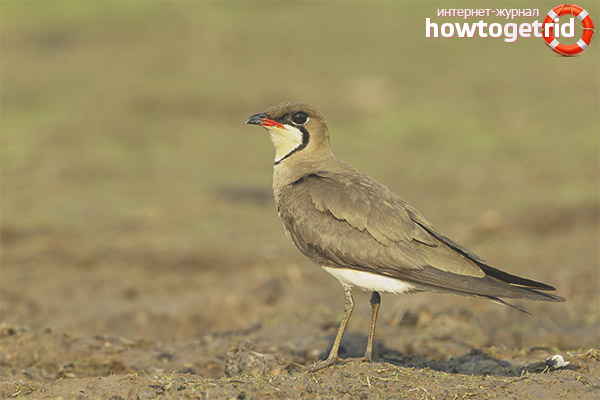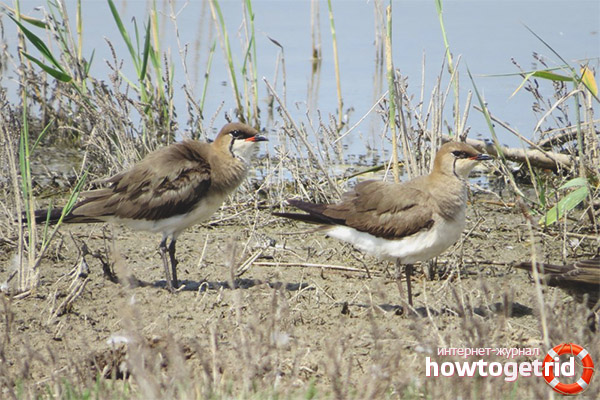The content of the article
The steppe birdie is an active and noisy bird. Its tail is forked, in flight it looks like a tern or swallow. Compared to other waders, her body composition is more elegant. The beak and legs of these birds are short.
Appearance
The steppe tirushka is very similar in appearance to the meadow. But the upper part of her body has a brownish and darker shade. The body length is about 25-26 cm. Males of this species weigh 90-105 g, females are 5-10 g less. The wingspan of the steppe tirushka is 60-67 cm.
In appearance and style of flight, it is somewhat similar to a swallow. Her tail is thymus and rather long. The body at the top is olive brown. The wings, as well as the area of the throat and chin are cream, and the chest is brown.
Habitat
In the south it lives up to the Black Sea coast. Sometimes it can fly to Norway and the British Isles. In winter, it can be found in eastern Africa, sometimes in the west, since the bird is a migratory bird.
They fly to nesting sites in April and May. They fly in small flocks in the daytime at different heights. Scientists believe that hungry birds fly lower than well-fed to get their own food. Fly away in August-September, depending on the habitat.
Habitat
It lives in the steppes, virgin or cultivated fields, river valleys. In Crimea, live near the lakes. For the colonies of these birds, it is important that there is water near the habitat. If the group of birds is small, they can settle quite far from the reservoir.
In ordinary habitats, the bird can be attributed to a fairly numerous species. The closer to the borders of the range, the less often they occur.
Behavior
In the daytime, the birdies descend to drink water and find food for themselves. Spend the night in the steppe. In the evening, they look for insects emerging from the grass on the road. If it’s very hot during the day, they can spend all day near a pond. The flight altitude depends on whether the bird is hungry or not. If it is full, it can fly quite high. If it is hungry, it flies lower, since at such a height you can find prey.
In the afternoon they fly to the nearest body of water to drink water. Sometimes they can swim, hitting their wings on the surface of the water.
If a bird of prey appears on the territory of nesting, a group of birdies simultaneously pounces on it. They drive the enemy as far away from their home as possible. If a person appears nearby, they can fly or run in a circle, pretend that they can’t fly, or pretend as if they are hatching eggs.
Breeding
They mate during the flight. Therefore, many females who have just flown in from wintering are ready to lay eggs soon. Nest in colonies. Groups can be small, and make up several tens of pairs. They can be found everywhere within the habitat. Sometimes a colony is up to several hundred pairs of jubiles.
In the places of their nesting meadow meadow bird can also nest. Among their nests, one can also find houses of herbalists or white-tailed piglets. Shiloklyuvki can locate their nests at the edges of the colony.
Many representatives of the species every year equip their nests in a new place, but at the same time choose the same conditions. The colony can be located not far from last year’s nesting place, or it can move a few kilometers away from it.
The bird's nest is an ordinary hole, which the birds themselves equip. It can be located in open areas or under bushes. They line the nest with grass. The nesting period lasts approximately 2 months. Usually the female lays about 4 eggs. Sometimes they can be 3 or 5. They have an oval shape. One side is slightly sharper than the other. They are located almost vertically, with a small slope.
There is no accurate data on the duration of incubation. The bird sits on eggs only at night, and also in the evening and in the early morning. During the day, she hunts in search of food. If it is very hot during the day, only a few representatives of the colonies remain to guard the nests, and the remaining birds fly away to the pond. If a person appears nearby during this period, they try to “divert” him.
When the chicks hatch, the birds begin to form flocks. Already in August they become numerous.
Nutrition
The main diet of the steppe tirushka is insects. These are such large representatives as locusts, grasshoppers and others. With the onset of autumn, it eats in the fields. In Africa, they feed on locusts, chasing them in large packs of several hundred or even thousands of individuals.
This bird needs protection, therefore it is in the Red Book. Scientists suggest that the entire world population numbers from 15 to 46 thousand pairs of these birds.
In recent years, it has been noted that the species is declining. Presumably, this is due to the development by man of large areas of virgin land, on which the birdies previously nested. In addition, with cattle grazing, a lot of clutches die. Therefore, conservationists believe that to preserve the species, grazing on the territory of the colonies during the nesting period must be strictly limited. For this, it is necessary to conduct active propaganda among the population, and to identify breeding sites. In addition, an increase in the number of corvids that prey on jacuzzi also affects the size of the species. In conditions of great drought, birds may not breed, skipping a year.











Submit